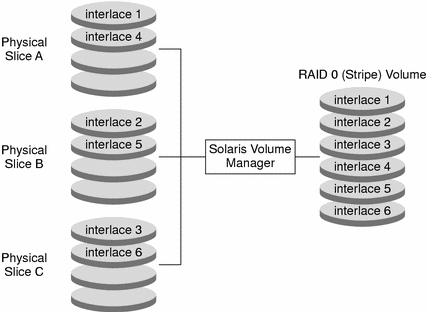RAID 0 (Stripe) Volume
A RAID 0 (stripe) volume is a volume that arranges data across one or more components. Striping alternates equally-sized segments of data across two or more components, forming one logical storage unit. These segments are interleaved round-robin, so that the combined space is made alternately from each component, in effect, shuffled like a deck of cards.
Striping enables multiple controllers to access data at the same time, which is also called parallel access. Parallel access can increase I/O throughput because all disks in the volume are busy most of the time servicing I/O requests.
An existing file system cannot be converted directly to a stripe. To place an existing file system on a stripe, you must back up the file system, create the stripe, then restore the file system to the stripe.
For sequential I/O operations on a stripe, Solaris Volume Manager reads all the blocks in a segment of blocks (called an interlace) on the first component, then all the blocks in a segment of blocks on the second component, and so forth.
For sequential I/O operations on a concatenation, Solaris Volume Manager reads all the blocks on the first component, then all the blocks of the second component, and so forth.
On both a concatenation and a stripe, all I/O occurs in parallel.
Interlace Values for Stripes
An interlace is the size, in Kbytes, Mbytes, or blocks, of the logical data segments on a stripe. Depending on the application, different interlace values can increase performance for your configuration. The performance increase comes from having several disk arms doing I/O. When the I/O request is larger than the interlace size, you might get better performance.
Note –
RAID 5 volumes also use an interlace value. See Overview of RAID 5 Volumes for more information.
When you create a stripe, you can set the interlace value or use the Solaris Volume Manager default interlace value of 16 Kbytes. Once you have created the stripe, you cannot change the interlace value. However, you could back up the data on it, delete the stripe, create a new stripe with a new interlace value, and then restore the data.
Scenario—RAID 0 (Stripe) Volume
Figure 7–1 shows a stripe that is built from three components (disks).
When Solaris Volume Manager stripes data from the volume to the components, it writes data from chunk 1 to Disk A, from chunk 2 to Disk B, and from chunk 3 to Disk C. Solaris Volume Manager then writes chunk 4 to Disk A, chunk 5 to Disk B, chunk 6 to Disk C, and so forth.
The interlace value sets the size of each chunk. The total capacity of the stripe d2 equals the number of components multiplied by the size of the smallest component. (If each slice in the following example were 2 Gbytes, d2 would equal 6 Gbytes.)
Figure 7–1 Stripe Example

- © 2010, Oracle Corporation and/or its affiliates
